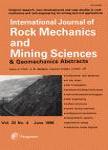版权所有:内蒙古大学图书馆 技术提供:维普资讯• 智图
内蒙古自治区呼和浩特市赛罕区大学西街235号 邮编: 010021

作者机构:Tsinghua Univ State Key Lab Hydrosci & Engn Beijing 100084 Peoples R China Tsinghua Univ Dept Hydraul Engn Beijing 100084 Peoples R China Tsinghua Univ Key Lab Hydrosphere Sci Minist Water Resources Beijing 100084 Peoples R China
出 版 物:《INTERNATIONAL JOURNAL OF ROCK MECHANICS AND MINING SCIENCES》 (Int. J. Rock Mech. Min. Sci.)
年 卷 期:2025年第186卷
核心收录:
学科分类:0819[工学-矿业工程] 08[工学] 0818[工学-地质资源与地质工程]
基 金:National Natural Science Foundation of China Open Research Fund Program of the State Key Laboratory of Hydroscience and Engineering of Tsinghua University [sklhse-2023-D-02] Program for International Exchange and Cooperation in Education by the Ministry of Education of the People's Republic of China
主 题:In-situ stress field Discontinuous Nonlinearity Improved LSTM algorithm
摘 要:Existence of discontinuous geological structures, such as folds and fault, poses a great challenge in predicting the in-situ stress fields (ISSF). This paper proposes a discontinuous intelligent inversion method to predict the ISSFs in the deep coal seam area (DCSA) of the Shanghai Temple, which exhibits distinct discontinuous geological features. The proposed method consists of three key components. First, a discontinuous loading model was developed to address the problem of accuracy in the numerical simulation of discontinuous tectonic regions such as folds and faults. The simulation data generated is used as a sample dataset for the training of the inversion algorithm and their completeness is fully guaranteed. Second, the statistical distribution patterns of horizontal, maximum and minimum lateral pressure coefficients (LPCs) of the ISSF in the typical DCSAs of China is statistically calculated. By applying Gaussian- and Cauchy-type fuzzy membership functions, the degree of influence of faults and folds on the local ISSF is quantified and the geological structure influence model is constructed. The influence value enriches the input data dimension of the algorithm and lays a more detailed data foundation for the stress inversion. Third, the improved Long Short-Term Memory (LSTM) network algorithm was constructed by optimizing the network hierarchy and multi-parameter cyclic learning. An inversion analysis is carried out using the ISSF around the borehole as an example, and the relative error strictly controlled within 1 %. The improved LSTM algorithm achieves an accuracy of 88.58 % at each measurement point in the Shanghai Temple deep coal seam project, which is significantly higher than that of the back propagation neural network (BPNN). The discontinuous intelligent inversion method proposed in this study can provide an effective tool for predicting the ISSF in DCSA.